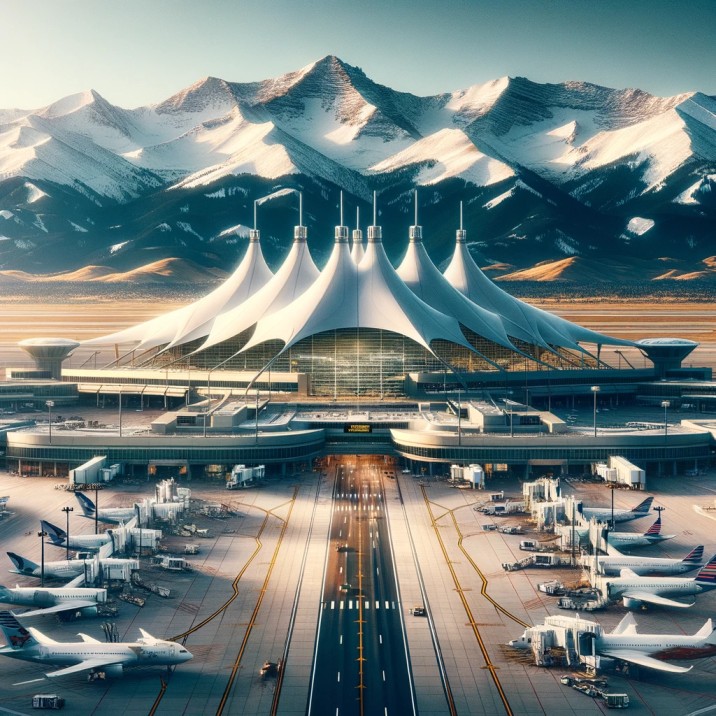What is the biggest US airport by size? The biggest airport in the United States by size is Denver International Airport (DEN), located in Denver, Colorado. Spanning a total area of approximately 33,531 acres (13,570 hectares), it is not only the largest airport in the U.S. but also one of the largest in the world. Denver International Airport is known for its distinctive peaked roof, designed to resemble the snow-capped Rocky Mountains, and its extensive land area, which includes multiple runways and a vast amount of open space.

Denver International Airport (DEN), standing as the largest airport in the United States by land area, is a marvel of modern aviation and a key hub in the global air transport network. This article delves into the history, development, and operational highlights of this iconic airport.
Historical Background
Denver International Airport, an icon of modern aviation, has a rich historical background that dates back to the 1980s. The story of its creation is intertwined with Denver’s growth and the need for a more advanced aviation hub to replace the aging Stapleton International Airport.
In the 1980s, Denver’s aviation needs were rapidly outgrowing Stapleton Airport’s capacity. Stapleton, beset with issues like noise complaints, a lack of space for expansion, and an inefficient layout, was proving inadequate for the city’s growing air traffic demands. Recognizing these challenges, city leaders and planners proposed the development of a new airport that would not only address these issues but also cater to the expected growth in air travel in the coming decades.
The construction of Denver International Airport began in 1989, marking the start of one of the most ambitious airport projects in American history. The project faced numerous challenges, including budget overruns and construction delays, partly due to the airport’s advanced automated baggage system, which was one of the most technologically complex systems of its time.
Despite these challenges, Denver International Airport opened on February 28, 1996. The new airport was immediately notable for its vast size, state-of-the-art facilities, and distinctive architecture. It was designed with expansion in mind, ensuring that it could grow alongside the city of Denver and continue to meet the evolving needs of global air travel.
Architectural Significance
The architectural significance of Denver International Airport extends beyond its functional design to become a symbol of Denver’s identity and ambition. The airport’s main terminal, the Jeppesen Terminal, is renowned for its striking tent-like roof structure. This design is not just an aesthetic choice; it reflects the region’s cultural heritage and natural environment. The roof’s peaks are reminiscent of the snow-capped Rocky Mountains, a landmark of the Colorado landscape, seamlessly blending the structure into its surroundings.
Designed by Fentress Bradburn Architects, the roof is made of Teflon-coated fiberglass, a material that is both lightweight and durable, suitable for Denver’s variable weather conditions. This innovative design choice not only gives the airport a unique visual identity but also serves a practical purpose by allowing natural light to permeate the space, creating a bright and welcoming atmosphere for travelers.
The Jeppesen Terminal’s architecture is a testament to the fusion of form and function, and it stands as an iconic gateway to the city. It reflects Denver’s spirit of innovation and its connection to the natural beauty of the region, making it a landmark not just in aviation architecture but also in the architectural identity of Denver.
Facilities and Capacity
Denver International Airport’s expansive facilities and immense capacity are tailored to accommodate the high volume of passenger and cargo traffic, ensuring efficient and seamless operations. The airport features a sprawling main terminal, the Jeppesen Terminal, named after aviation pioneer Elrey Borgen Jeppesen, and three airside concourses – A, B, and C – accessible via an automated underground train system.
Concourse A, directly connected to the terminal by a pedestrian bridge, primarily serves domestic flights and includes a customs and immigration facility for international arrivals. Concourses B and C handle additional domestic and international flights, with Concourse B being a major hub for United Airlines.
With a total of 111 gates across all concourses and plans for further expansion, DEN is equipped to handle a vast number of flights and passengers daily. The airport’s design emphasizes passenger comfort and operational efficiency, with spacious waiting areas, a wide range of dining and shopping options, and state-of-the-art baggage handling systems. The airport’s runways, among the longest in the United States, can accommodate any type of aircraft, including the Airbus A380, the world’s largest passenger airliner. This capacity makes Denver International Airport a vital node in both national and international air travel networks, ready to meet the growing demands of modern aviation.
Operational Statistics
As of my last update, DEN consistently ranked among the top airports in the world in terms of passenger traffic and aircraft movements. Annually, it handles over 69 million passengers and accommodates hundreds of thousands of flights, connecting Denver to destinations across the globe.
Economic and Strategic Importance
The airport serves as a significant economic engine for the Denver region and Colorado. It creates thousands of jobs and contributes billions to the local economy. Additionally, DEN serves as a major hub for several airlines, including United Airlines and Frontier Airlines, making it a critical node in the national and international air transport system.
Sustainability and Innovation
Denver International Airport is also at the forefront of sustainability and technological innovation in the aviation industry. It has implemented various green initiatives, such as solar power projects and environmental management programs, aiming to reduce its carbon footprint and promote eco-friendly operations.
Art and Culture
Beyond its operational and economic roles, DEN is known for its art installations and cultural displays. The airport houses a diverse collection of artworks, ranging from sculptures and murals to installations, enriching the travel experience and reflecting Denver’s vibrant cultural scene.
Looking towards the future, Denver International Airport is continuously evolving. Plans for expansion and modernization are underway, focusing on increasing capacity, enhancing passenger experience, and integrating advanced technologies to keep pace with the growing demands of global aviation.
Denver International Airport stands as a testament to human ingenuity in engineering and a symbol of Denver’s gateway to the world. From its remarkable design to its significant role in global air travel, DEN is not just an airport; it’s a landmark of progress, connection, and cultural expression. As it continues to grow and adapt, Denver International Airport remains a pivotal player in shaping the future of air transportation, both in the United States and worldwide.

